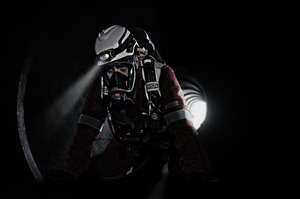
 |
Mark Sennett
Managing Editor |
 |
Kelly Rose
Editor |
| Home> | PPE | >Head Protection | >Head for safety |
Head for safety
05 December 2022
MSA provides in insight into the important things to consider when investing in the right safety helmet to ensure it provides you with the right level of safety.

To give every worker the best chance of avoiding serious damage from a falling object to the head or accidental contact with electrical conductors, it is vital to ensure the highest quality, most appropriate hard hat is worn for any given application.
Hard hats must be appropriate to the workers’ task and working environment, they must fit, be comfortable and provide the correct level of safety. Providing good, comfortable, fit for purpose PPE including Hard Hats can have a positive effect on a workers job satisfaction and their productivity.
Key questions you need to ask while choosing the best hard hat
The list below suggests several questions you might want to consider while researching the right safety helmets, linking them to a preliminary risk analysis.
-
Does it comply with the relevant standards?
Failing to comply can result in significant fines and reputational damage for your organisation. Always check that your safety helmets have the CE or the UKCA marking and comply with the relevant EN approval. Depending on your risk analysis, this EN could be EN397, EN12492 or EN14052. However, the safety helmets approved to EN are not equal. Always check the helmet EN certificate or approval information on the shell, the brim or the label of your safety helmet carefully to understand exactly what the helmet has been tested against. In particular, optional requirements within the EN397 standard, such as very low temperatures (-20°C or -30°C), very high temperatures (+150°C), lateral deformation (LD), molten metal (MM), and electrical insulation (440 V), should always be considered in specific applications or environments.
-
Is it comfortable?
A comfortable helmet is much more likely to be worn than one that doesn’t fit properly. Comfort is not only about the weight of the helmet - a lightweight helmet with a poor-quality suspension will not be comfortable. The helmet’s suspension should enable a quick and secure fitting on the operators’ head and make the helmet balanced and stabilised, no matter the head movements. For the sweatband in direct contact with the forehead, search for a sweatband made of a soft, sweat-absorbing, respiring material that can be washed and replaced. Issues with the balance and stability of the helmet could be a real safety issue. An additional layer of comfort and safety can be added with certified accessories, such as seasonal liners, for workers involved in outdoor activities, protecting them from cold, heat or harmful UV.
-
Is it vented or non-vented?
This should be defined from your risk analysis. Users generally opt for a non-vented helmet in the following cases: electrical activities, risks of projections of chemicals, hot liquids or other liquids on the head, or work in a cold temperature environment. A vented helmet will perform well when working outdoors in high temperatures or if the workers must travel significant distances and are likely to perspire.
-
Should it have a chinstrap?
Chinstraps are mandatory components of EN12492-approved helmets and whenever you work at height (even if you use an EN397-approved helmet!). Some manufacturers recommend always using chinstraps – even when working at the floor level – as they can potentially help improve workers’ safety. For your compliance and safety, always use a chinstrap that is certified with your helmet and enables multiple adjustments for a perfect fit.
-
Can accessories be added?
Safety helmets serve as a safety platform for other types of PPE that may be required based on your risk analysis, such as helmet-mounted ear defenders or face shields. Always ensure that the accessory and PPE you attach have been certified to be used with your helmet. For instance, whenever you need to attach ear defenders to your hard hat, check the ear-defenders product manual to review the list of their compatible hard hats. If you need to attach a face shield on your helmet – by using a carrier or by attaching it on a carrier integrated to the helmet shell – always make sure that all components – helmet, carrier, face-shield – have been tested and certified to be combined.
-
Can it be customised?
Helmet customisation can serve many purposes. Branded helmets help promote your company brand anywhere, reinforce safety messages, enhance compliance and much more. In addition to ensuring better visibility of your workers, retro-reflective stickers can be used to identify certain workers’ positions. Never use stickers that the helmet’s manufacturer does not approve, and never write or paint on your helmet, as this can lead to a loss in the expected protective performance of your helmet. Finally, most helmets on the market are available in various colours to fit your company brand policy, identify a specific position or be more visible.
-
Is it easy to use?
That’s an important criterion of choice to increase the likelihood of the helmet being effectively worn. That can be about the ability to quickly size the hard hat to a secure fit that remains comfortable, including when wearing safety gloves; the ease of washing or replacing your suspension sweatband on the field; and the ease of fitting your chinstrap and replace it onsite.
Making the right choice is critical, primarily for the safety of your workforce but also for their comfort, confidence, and productivity. We recommend involving your workforce in the helmet selection process, making them more likely to wear a helmet they helped to select. Before you buy any safety helmet, we remind you that you should refer to your risk assessments and all applicable standards and legislation.
For more information, visit www.msasafety.com
























